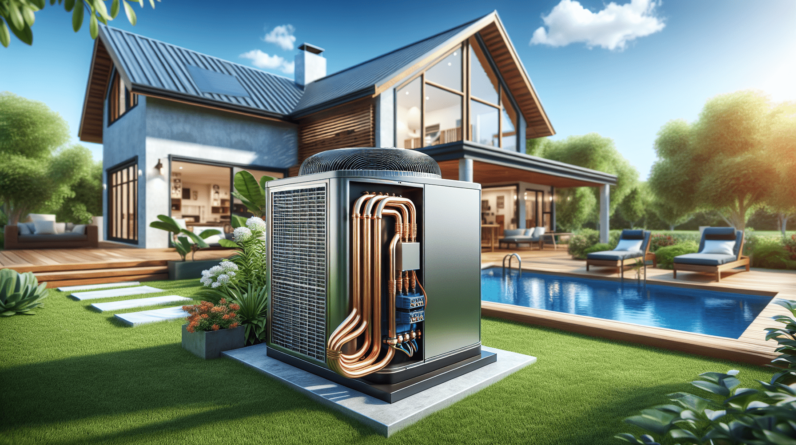
In the world of HVAC, operating systems play a crucial role in maintaining a comfortable indoor environment. However, like any technology, these systems are not immune to problems. From faulty sensors to inefficient controls, there are several issues that can arise in a typical operating system. In this article, we will explore some of the most common problems encountered in HVAC operating systems, offering insights and solutions to help you keep your system running smoothly. So whether you’re a homeowner or a building manager, read on to discover how to tackle these pesky HVAC woes and ensure optimal performance in your space.
1. Sensor Malfunction
1.1 Faulty temperature sensors
One common issue that can occur in HVAC systems is malfunctioning temperature sensors. These sensors are responsible for monitoring the temperature of the surrounding environment and providing this information to the control software. If the temperature sensors are faulty, they may inaccurately measure the temperature, leading to incorrect adjustments in the system’s settings. This can result in inefficient heating or cooling, leading to discomfort and higher energy consumption.
1.2 Inaccurate humidity sensors
Humidity sensors are essential components of HVAC systems as they detect the level of moisture in the air. When these sensors malfunction, they may provide inaccurate readings, leading to improper humidity control. High humidity can cause discomfort and promote the growth of mold and mildew, while low humidity levels can lead to dryness and respiratory problems. It is crucial to ensure that the humidity sensors are functioning correctly to maintain a comfortable and healthy indoor environment.
1.3 Failed pressure sensors
Pressure sensors play a critical role in HVAC systems by monitoring the pressure levels throughout various components, such as compressors and refrigerant lines. A failed pressure sensor can result in an imbalanced distribution of pressure, leading to inefficient operation and potential damage to the system. Additionally, inaccurate pressure measurements can lead to incorrect adjustments in the control software, resulting in further operational issues. Regular maintenance and inspections are essential to detect and address any failed pressure sensors promptly.
2. Control Software Glitches
2.1 Inconsistent setpoint controls
The control software of an HVAC system is responsible for maintaining the desired temperature and humidity levels. However, glitches in the software can cause inconsistent setpoint controls, leading to temperature fluctuations and discomfort. For instance, the system may not accurately maintain the set temperature, resulting in inefficient operation and increased energy consumption. Regular software updates and thorough testing can help prevent and resolve these glitches.
2.2 Incorrect scheduling
Proper scheduling is crucial for optimal HVAC system operation. However, control software glitches can lead to incorrect scheduling, causing the system to operate at unnecessary times or fail to activate when needed. This can result in wasted energy and discomfort for the occupants. Regular software maintenance and periodic adjustments to the scheduling settings can help prevent these issues and ensure the HVAC system operates efficiently.
2.3 Unresponsive user interfaces
User interfaces allow individuals to interact with the HVAC system, adjust settings, and monitor its operation. When the user interface becomes unresponsive, it can be frustrating and hinder the ability to control the system effectively. Unresponsive user interfaces can be caused by software glitches or hardware malfunctions. Timely troubleshooting and repairs are necessary to restore the functionality of the user interface and ensure smooth operation of the HVAC system.
3. Communication Failures
3.1 Network connectivity issues
Modern HVAC systems often rely on network connectivity for efficient operation and remote control capabilities. However, network connectivity issues can hinder the communication between HVAC system components and the control software. This can lead to a loss of control, improper adjustments, and even complete system failures. Regular monitoring of network connectivity and prompt troubleshooting of any issues can help maintain a reliable and stable communication network for the HVAC system.
3.2 Incompatible protocols
HVAC systems often involve various components from different manufacturers, each using their own communication protocols. Incompatible protocols can hinder the exchange of information between these components, leading to communication failures. As a result, the HVAC system may not operate optimally and may struggle to maintain the desired conditions. Proper integration and compatibility testing during the installation process can help prevent these issues and ensure smooth communication between components.
3.3 Communication interference
HVAC systems in large buildings or areas with complex electrical systems may experience communication interference. This interference can disrupt the signals between components, causing communication failures. Common sources of interference include electromagnetic radiation, radio waves, and nearby electronic devices. Proper shielding and isolation techniques, as well as regular inspection and maintenance, can help minimize communication interference and ensure uninterrupted operation of the HVAC system.
4. Equipment Malfunctions
4.1 Motor or fan failures
Motors and fans are crucial components in HVAC systems, responsible for moving air, refrigerant, and other fluids throughout the system. When these motors or fans fail, the airflow can be compromised, leading to inefficient heating or cooling and potential system overheating. Regular maintenance and inspections should include checking for any signs of motor or fan failures to prevent operational issues and costly repairs.
4.2 Leaking valves or pipes
Leaking valves or pipes in an HVAC system can lead to various problems, including reduced system efficiency, uneven heating or cooling, and potential water damage. Leaks can occur due to wear and tear, corrosion, or improper installation. Regular inspections, timely repairs, and proper maintenance can help detect and address any leaks, preventing further damage to the system and maintaining its performance.
4.3 Freezing or overheating coils
Coils in HVAC systems play a crucial role in heat transfer and refrigeration processes. However, when coils freeze or overheat, the system’s efficiency is significantly compromised. Freezing coils can occur due to refrigerant leaks, inadequate airflow, or dirty air filters. Overheating coils, on the other hand, can result from excessive heat load, insufficient refrigerant flow, or airflow restrictions. Regular maintenance, monitoring, and prompt repairs are essential to prevent coil freezing or overheating and ensure optimal system performance.
5. Faulty Wiring
5.1 Loose or disconnected connections
Proper electrical connections are essential for the safe and efficient operation of an HVAC system. Loose or disconnected wiring can result in intermittent system failures, electrical malfunctions, or even electrical hazards. Regular inspections and tightening of connections can help prevent these issues and maintain a reliable electrical system.
5.2 Short circuits
Short circuits occur when electrical current takes an unintended path due to damaged or crossed wires. In an HVAC system, short circuits can lead to system malfunctions, component failures, or electrical fires. Proper electrical installation, regular inspections, and prompt repairs of any damaged wires are necessary to prevent short circuits and maintain the safety and reliability of the system.
5.3 Wiring damage or degradation
Over time, the wiring in an HVAC system can degrade due to factors such as environmental conditions, pests, or physical damage. Damaged or degraded wiring can result in system failures, intermittent operation, or safety hazards. Regular inspections and maintenance, including rewiring when necessary, can help prevent these issues and ensure the long-term performance and safety of the HVAC system.
6. Refrigerant Leaks
6.1 Leaky valves or fittings
Refrigerant leaks in HVAC systems can have detrimental effects on system performance, efficiency, and environmental impact. Leaky valves or fittings are common culprits for refrigerant leaks. These leaks can lead to insufficient cooling or heating, increased energy consumption, and potential harm to the ozone layer. Regular inspections and prompt repairs of any leaks can help prevent these issues and ensure optimal refrigerant levels within the system.
6.2 Damaged coils or tubing
Coils and tubing in an HVAC system are integral for the circulation and transfer of refrigerant. However, when these components become damaged, refrigerant leaks can occur. Damaged coils or tubing can result from corrosion, physical impact, or wear and tear. Identifying and repairing any damaged coils or tubing as part of regular maintenance can help prevent refrigerant leaks and maintain the efficiency of the HVAC system.
6.3 Corrosion in refrigerant lines
Corrosion in refrigerant lines is another common cause of refrigerant leaks in HVAC systems. Corrosion can occur due to various factors, including chemical reactions between the refrigerant and the materials used in the lines or environmental conditions. Regular inspections, preventive measures such as proper insulation and coatings, and timely repairs are essential to prevent and address corrosion in the refrigerant lines, ensuring the integrity of the system.

7. Energy Management Issues
7.1 Inefficient energy usage
Efficient energy usage is crucial for both environmental sustainability and cost savings. However, HVAC systems can suffer from inefficient energy usage due to factors such as outdated control algorithms, improper system sizing, or faulty components. Inefficient energy usage can lead to excessive energy consumption and unnecessary expenses. Regular energy audits, system optimization, and upgrades can help identify and address energy management issues, promoting energy efficiency in HVAC systems.
7.2 Inadequate load balancing
Load balancing refers to the distribution of heating or cooling load within an HVAC system to ensure optimal operation and energy efficiency. Inadequate load balancing can result from improper system design, component malfunctions, or changing environmental conditions. When load balancing is inadequate, certain areas may receive insufficient heating or cooling, leading to discomfort and potential system inefficiency. Regular system inspections and adjustments can help achieve proper load balancing, ensuring all areas are adequately serviced by the HVAC system.
7.3 Lack of energy monitoring
Monitoring energy consumption is essential to identify patterns, trends, and potential energy-saving opportunities in an HVAC system. However, the lack of energy monitoring capabilities can hinder the ability to assess system performance and identify areas for improvement. Implementing energy monitoring systems or partnering with energy management service providers can help overcome this issue and enhance energy management practices in HVAC systems.
8. Airflow Problems
8.1 Clogged filters
Air filters in HVAC systems help maintain clean indoor air quality by trapping dust, pollutants, and allergens. However, when these filters become clogged, airflow can be restricted, leading to reduced system efficiency and compromised air quality. Regular filter inspections and replacements are necessary to prevent clogging and ensure proper airflow throughout the HVAC system.
8.2 Duct leaks or blockages
Ducts play a crucial role in distributing heated or cooled air throughout a building. Leaks or blockages in the ducts can result in improper airflow, inconsistent temperatures, and reduced system efficiency. Leaks can occur due to damaged or improperly sealed ducts, while blockages can be caused by debris or pests. Regular duct inspections and prompt repairs can help prevent these issues and maintain optimal airflow in the HVAC system.
8.3 Inadequate ventilation
Proper ventilation is essential for maintaining a healthy and comfortable indoor environment. Inadequate ventilation in an HVAC system can result from improper system design, inadequate air exchange rates, or blocked ventilation openings. Poor ventilation can lead to stale air, increased humidity, and the buildup of contaminants. Regular system evaluations, ventilation assessments, and adjustments can help ensure adequate ventilation and promote a healthy indoor environment.
9. System Compatibility
9.1 Incompatible hardware components
HVAC systems often consist of various hardware components from different manufacturers and models. Incompatibility between these components can lead to operational issues, communication failures, or system malfunctions. Proper system design, compatibility checks, and integration testing during installation are necessary to ensure that all hardware components work together seamlessly.
9.2 Ineffective integration with other systems
HVAC systems often need to integrate with other building management systems, such as lighting or security systems, to achieve optimal performance and energy efficiency. Ineffective integration between these systems can result in coordination problems, communication breakdowns, or conflicting control settings. Thorough integration planning, compatibility testing, and ongoing monitoring and adjustments can help ensure effective integration and interoperability between the HVAC system and other building systems.
9.3 Software compatibility issues
Software compatibility issues can arise when the HVAC system software is not compatible with the operating system or other software used in the building. Incompatibility can lead to functionality limitations, system errors, or communication failures. Regular software updates, compatibility tests, and working with reputable software providers can help prevent software compatibility issues and ensure smooth operation of the HVAC system.
10. Cybersecurity Vulnerabilities
10.1 Weak password policies
As HVAC systems become increasingly connected and integrated with networks, they are vulnerable to cybersecurity threats. Weak password policies can make it easier for unauthorized individuals to gain access to the system, potentially causing disruptions, controlling the environment, or compromising sensitive information. Implementing strong password policies, regular password updates, and multi-factor authentication can help mitigate cybersecurity vulnerabilities in HVAC systems.
10.2 Lack of encryption
Data encryption is crucial for protecting sensitive information transmitted and stored within an HVAC system. Without encryption, data can be intercepted, tampered with, or stolen by malicious individuals. Implementing robust encryption methods and protocols can help safeguard data and ensure the integrity and confidentiality of the HVAC system’s information.
10.3 Vulnerable remote access
Remote access capabilities in HVAC systems provide convenience and flexibility for monitoring and controlling the system from remote locations. However, if remote access features are not adequately protected, they can become entry points for hackers. Vulnerable remote access can lead to unauthorized control of the HVAC system, potential disruptions or damage, or unauthorized access to the building’s network. Implementing secure remote access protocols, robust authentication mechanisms, and regular security audits can help mitigate cybersecurity risks associated with remote access in HVAC systems.
In conclusion, a typical operating system in HVAC can experience various problems, ranging from sensor malfunctions to cybersecurity vulnerabilities. Regular maintenance, inspections, and prompt repairs are crucial to address these issues and ensure optimal performance, energy efficiency, and occupant comfort in HVAC systems. With proper attention and proactive measures, the reliability and effectiveness of HVAC systems can be significantly improved.






